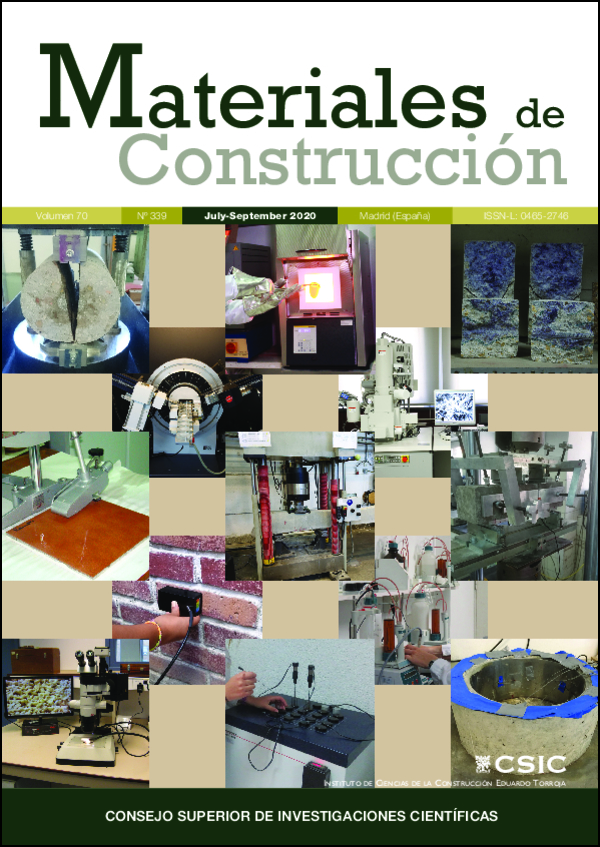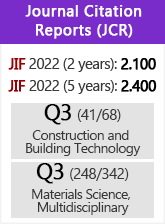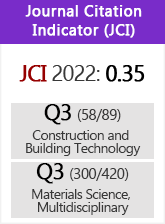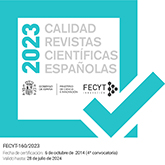Behaviour of a high-performance self-compacting concrete (HPSCC) with ternary mixtures of nano- and microsilica in the presence of chlorides
DOI:
https://doi.org/10.3989/mc.2020.10619Keywords:
High-performance concrete, Active addition, Durability, Diffusion, CorrosionAbstract
In this paper, the influence of additions of nanosilica (nSi) and microsilica (mSi) on the behaviour of binary and ternary mixtures in chloride environments is studied. The main objective is to obtain high-performance self-compacting concrete (HPSCC) with a high durability which can meet specific demands in such aggressive environments. Ten blends were manufactured using Portland cement (CEM I 52.5 R) and additions of nSi and mSi in binary and ternary mixtures. The results of three tests frequently used to evaluate resistance to chloride penetration– electrical resistivity, migration and chloride diffusion –were studied and compared. Both binary and ternary mixtures presented significant improvements in chloride resistance, generally in proportion to the total content of the addition. In all the ternary mixtures, high resistivity is obtained, which indicates that such mixtures have a notably low chloride penetrability. Furthermore, these mixtures provided extremely low chloride diffusion coefficients even at small addition ratios.
Downloads
References
Siddique, R. (2013) Compressive strength, water absorption, sorptivity, abrasion resistance and permeability of self-compacting concrete containing coal bottom ash. Construc. Build. Mat. 47, 1444-1450. https://doi.org/10.1016/j.conbuildmat.2013.06.081
Łaźniewska-Piekarczyk, B. (2014) The methodology for assessing the impact of new generation superplasticizers on air content in self-compacting concrete. Construc. Build. Mat. 53, 488-502. https://doi.org/10.1016/j.conbuildmat.2013.11.092
Mohammed, M.K.; Dawson, A.R.; Thom, N.H. (2014) Carbonation of filler typed self-compacting concrete and its impact on the microstructure by utilization of 100% CO2 accelerating techniques. Construc. Build. Mat. 50, 508-516. https://doi.org/10.1016/j.conbuildmat.2013.09.052
Druta, C.; Wang, L.; Lane, D.S. (2014) Tensile strength and paste-aggregate bonding characteristics of self-consolidating concrete. Construc. Build. Mat. 55, 89-96. https://doi.org/10.1016/j.conbuildmat.2014.01.010
Jalal, M.; Pouladkhan, A.; Harandi, O.F.; Jafari, D. (2015) Comparative study on effects of Class F fly ash, nano silica and silica fume on properties of high performance self-compacting concrete. Construc. Build. Mat. 94, 90-104. https://doi.org/10.1016/j.conbuildmat.2015.07.001
Güneyisi, E.; Gesoglu, M.; Al-Goody, A.; Ipek, S. (2015) Fresh and rheological behavior of nano-silica and fly ash blended self-compacting concrete. Construc. Build. Mat. 95, 29-44. https://doi.org/10.1016/j.conbuildmat.2015.07.142
Hemalatha, T.; Ram Sundar, K.R.; Ramachandra Murthy, A.; Iyer, N. R. (2015) Influence of mixing protocol on fresh and hardened properties of self-compacting concrete. Construc. Build. Mat. 98, 119-127. https://doi.org/10.1016/j.conbuildmat.2015.08.072
Puentes, J.; Barluenga, G.; Palomar, I. (2015) Effect of silica-based nano and micro additions on SCC at early age and on hardened porosity and permeability. Construc. Build. Mat. 81, 154‑161. https://doi.org/10.1016/j.conbuildmat.2015.02.053
Leung, H.Y.; Kim, J.; Nadeem, A.; Jaganathan, J.; Anwar, M.P. (2016) Sorptivity of self-compacting concrete containing fly ash and silica fume. Construc. Build. Mat. 113, 369- 375. https://doi.org/10.1016/j.conbuildmat.2016.03.071
Tian, J.; Wang, W.; Du, Y. (2016) Damage behaviors of self-compacting concrete and prediction model under coupling effect of salt freeze-thaw and flexural load. Construc. Build. Mat. 119, 241-250. https://doi.org/10.1016/j.conbuildmat.2016.05.073
Asadollahi, S.; Saeedian, A.; Dehestani, M.; Zahedi, F. (2016) Improved compressive fracture models for self-consolidating concrete (SCC). Construc. Build. Mat. 123, 473- 480. https://doi.org/10.1016/j.conbuildmat.2016.07.030
Specification and Guidelines for Self-Compacting Concrete. (2005) European Federation for Specialist Construction Chemicals and Concrete Systems EFNARC.
Instrucción de Hormigón Estructural (EHE). (2010) Ministerio de Fomento, Secretaría General Técnica, Madrid.
Nepomuceno, M.C.S.; Oliveira, L.A.; Lopes, S.M.R. (2014) Methodology for mix design of self-compacting concrete using different mineral additions in binary blends of powders. Construc. Build. Mat. 26, 317-326. https://doi.org/10.1016/j.conbuildmat.2011.06.027
Shi, C.; Wu, Z.; Lv, K.; Wu, L. (2015) A review on mixture design methods for self-compacting concrete. Construc. Build. Mat. 84, 387-398. https://doi.org/10.1016/j.conbuildmat.2015.03.079
Ye, G.; Liu, X.; De Schutter, G.; Poppe, A.-M.;, Taerwe, L. (2007) Influence of limestone powder used as filler in SCC on hydration and microstructure of cement pastes. Cem. Concr. Compos. 29, 94-102. https://doi.org/10.1016/j.cemconcomp.2006.09.003
Barluenga, G.; Palomar, I.; Puentes, J. (2015) Hardened properties and microstructure of SCC with mineral additions. Construc. Build. Mat. 94, 728-736. https://doi.org/10.1016/j.conbuildmat.2015.07.072
Jalal, M.; Pouladkhan, A.; Harandi, O.F.; Jafari, D. (2015) Comparative study on effects of Class F fly ash, nano silica and silica fume on properties of high performance self-compacting concrete. Construc. Build. Mat. 94, 90-104. https://doi.org/10.1016/j.conbuildmat.2015.07.001
Owsiak, Z.; Grzmil, W. (2015) The evaluation of the influence of mineral additives on the durability of self-compacting concretes. KSCE J. Civil Engineer. 19, 1002-1008. https://doi.org/10.1007/s12205-013-0336-7
Ghafari, E.; Costa, H.; Júlio, E.; Portugal, A.; Durães, L. (2014) The effect of nanosilica addition on flowability, strength and transport properties of ultra-high performance concrete. Mater. Design. 59, 1‑9. https://doi.org/10.1016/j.matdes.2014.02.051
Li, Z.; Peng, J.; Ma, B. (1999) Investigation of chloride diffusion for high-performance concrete containing fly ash, microsilica and chemical admixtures. ACI Mater. J. 96, 391-396. https://doi.org/10.14359/638
Björnstrom, J.; Martinelli, A.; Matic, A.; Börjesson, L.; Panas, I. (2004) Accelerating effects of colloidal nano-silica for beneficial calcium-silica-hydrate formation in cement. Chem. Phys. Lett. 392 [1-3], 242-248. https://doi.org/10.1016/j.cplett.2004.05.071
Jo, B-W.; Kim, C-H.; Tae, G-H.; Park. J-B. (2007) Characteristics of cement mortar with nano-SiO2 particles. Construc. Build. Mat. 21, 1351‑1355. https://doi.org/10.1016/j.conbuildmat.2005.12.020
Kawashima, S.; Hou, P.; Corr, D.J.; Shah, S.P. (2013) Modification of cement-based materials with nanoparticles. Cem. Concr. Compos. 36, 8‑15. https://doi.org/10.1016/j.cemconcomp.2012.06.012
Rong, Z.; Sun, W.; Xiao, H.; Jiang, G. (2015) Effects of nano-SiO2 particles on the mechanical and microstructural properties of ultra-high performance cementitious composites. Cem. Concr. Compos. 56, 25‑31. https://doi.org/10.1016/j.cemconcomp.2014.11.001
Balapour, M.; Joshaghani, A.; Althoey, F. (2018) Nano- SiO2 contribution to mechanical, durability, fresh and microstructural characteristics of concrete: A review. Construc. Build. Mat. 181, 27-41. https://doi.org/10.1016/j.conbuildmat.2018.05.266
Gesoglu, M.; Güneyisi, E.; Asaad, D.S.; Muhyaddin, G.F. (2016) Properties of low binder ultra-high performance cementitious composites: Comparison of nanosilica and microsilica. Construc. Build. Mat. 102, 706-713. https://doi.org/10.1016/j.conbuildmat.2015.11.020
Bernal, J.; Reyes, E.; Massana, J.; León, N.; Sánchez, E. (2018) Fresh and mechanical behavior of a self-compacting concrete with additions of nano-silica, silica fume and ternary mixtures. Construc. Build. Mat. 160, 196-210. https://doi.org/10.1016/j.conbuildmat.2017.11.048
Massana, J.; Reyes, E.; Bernal, J.; León, N.; Sánchez- Espinosa, E. (2018) Influence of nano- and micro-silica additions on the durability of a high-performance self-compacting concrete. Construc. Build. Mat. 165, 93-103. https://doi.org/10.1016/j.conbuildmat.2017.12.100
Ryan, P.C.; O'Connor, A. (2016) Comparing the durability of self-compacting concretes and conventionally vibrated concretes in chloride rich environments. Construc. Build. Mat. 120, 504-513. https://doi.org/10.1016/j.conbuildmat.2016.04.089
UNE-EN 197-1:2011 Cement - Part 1: Composition, specifications and conformity criteria for common cements. Asociación Española de Normalización y Certificación AENOR. www.aenor.es.
UNE 12620:2003+A1:2009 Aggregates for concrete. Asociación Española de Normalización y Certificación, AENOR. www.aenor.es.
UNE 83988-1:2008 Concrete durability. Test methods. Determination of the electrical resistivity. Part 1: Direct test (reference method), Asociación Española de Normalización y Certificación AENOR. www. aenor.es.
ASTM C1202-18 (2018) Standard Test Method for Electrical Indication of Concrete's Ability to Resist Chloride Ion Penetration. ASTM International.
NT BUILD 492 (1999) Concrete, mortar and cement-based repair materials: Chloride migration coefficient from non-steady-state migration experiments. Nordtest. ISSN 0283-7153.
CEN/TS 12390-11:2010 Testing hardened concrete - Part 11: Determination of the chloride resistance of concrete, unidirectional diffusion. European Committee for Standardization.
UNE-EN 14629:2007 Products and systems for the protection and repair of concrete structures - Test methods - Determination of chloride content in hardened concrete, Asociación Española de Normalización y Certificación. AENOR. http://www.aenor.es.
RILEM Publications. (2002). Analysis of total chloride content in concrete. Mater. Struct. 35, 583-585. https://doi.org/10.1007/BF02483128
Sing, K.S.W.; Everett, D.H.; Haul, R.A.W.; Moscou, L.; Pierotti, R.A.; Rouquerol, J.; et al. (1985) IUPAC (Recommendations 1984), Reporting physisorption data for gas/solid systems with special reference to the determination of surface area and porosity. Pure Appl. Chem. 57, 603-619.
Polder, R.B. (2001) Test methods for on-site measurement of resistivity of concrete. RILEM TC-154 technical recommendation. Constr. Build. Mater. 15, 125-131. https://doi.org/10.1016/S0950-0618(00)00061-1
Basheer, P.; Gilleece, P;. Long, A.; Mc Carter, W. (2002) Monitoring electrical resistance of concretes containing alternative cementitious materials to assess their resistance to chloride penetration. Cem. Concr. Compos. 24, 437-449. https://doi.org/10.1016/S0958-9465(01)00075-0
Rajabipour, F.; Weiss, J.; Shane, J.D.; Mason, T.O.; Shah, S.P. (2005) Procedure to interpret electrical conductivity measurements in cover concrete during rewetting. J. Mater. Civ. Eng. 17, 586-594. https://doi.org/10.1061/(ASCE)0899-1561(2005)17:5(586)
McPolin, D.; Basheer, P.A.M.; Long, A.E.; Grattan, K.T.V.; Sun, T. (2005) Obtaining progressive chloride profiles in cementitious materials. Constr. Build. Mater. 19, 666-673. https://doi.org/10.1016/j.conbuildmat.2005.02.015
Andrade, C.;. D'Andrea, R.; Rebolledo, N. (2014) Chloride ion penetration in concrete: the reaction factor in the electrical resistivity model. Cem. Concr. Compos. 47, 41-46. https://doi.org/10.1016/j.cemconcomp.2013.09.022
Romero Mendoza, H.R. (2011) Deterioro del hormigón sometido a ensayos acelerados de hielo-deshielo en presencia de cloruros, PhD dissertation, Escuela Técnica Superior de Ingeniería de Caminos, Canales y Puertos, Universidad Politécnica de Madrid, Madrid, Spain.
Jalal, M.; Mansouri, E.; Sharifipour, M.; Pouladkhan, A.R. (2012) Mechanical, rheological, durability and microstructural properties of high performance self-compacting concrete containing SiO2 micro and nanoparticles. Mater. Design. 34, 389-400. https://doi.org/10.1016/j.matdes.2011.08.037
Li, L.G.; Zhu, J.; Huang, Z.H.; Kwan, A.K.H.; Li, L.J. (2017) Combined effects of micro-silica and nano-silica on durability of mortar. Construc. Build. Mat. 157, 337-347. https://doi.org/10.1016/j.conbuildmat.2017.09.105
Zahedi, M.; Ramezanianpour, A.A.; Ramezanianpour, A.M. (2015) Evaluation of the mechanical properties and durability of cement mortars containing nanosilica and rice husk ash under chloride ion penetration. Construc. Build. Mat. 78, 354-361. https://doi.org/10.1016/j.conbuildmat.2015.01.045
Alonso-Domínguez, D.; Álvarez-Serrano, I.; Reyes, E.; Moragues, A. (2017) New mortars fabricated by electrostatic dry deposition of nano and microsilica additions: Enhanced properties. Construc. Build. Mat. 135, 186-193. https://doi.org/10.1016/j.conbuildmat.2017.01.011
Olsson, N.; Lothenbach, B.; Baroghel-Bouny, V.; Nilsson, L-O. (2018) Unsaturated ion diffusion in cementitious materials - The effect of slag and silica fume. Construc. Build. Mat. 108, 31-37. https://doi.org/10.1016/j.cemconres.2018.03.007
Published
How to Cite
Issue
Section
License
Copyright (c) 2020 Consejo Superior de Investigaciones Científicas (CSIC)

This work is licensed under a Creative Commons Attribution 4.0 International License.
© CSIC. Manuscripts published in both the printed and online versions of this Journal are the property of Consejo Superior de Investigaciones Científicas, and quoting this source is a requirement for any partial or full reproduction.All contents of this electronic edition, except where otherwise noted, are distributed under a “Creative Commons Attribution 4.0 International” (CC BY 4.0) License. You may read here the basic information and the legal text of the license. The indication of the CC BY 4.0 License must be expressly stated in this way when necessary.
Self-archiving in repositories, personal webpages or similar, of any version other than the published by the Editor, is not allowed.


















